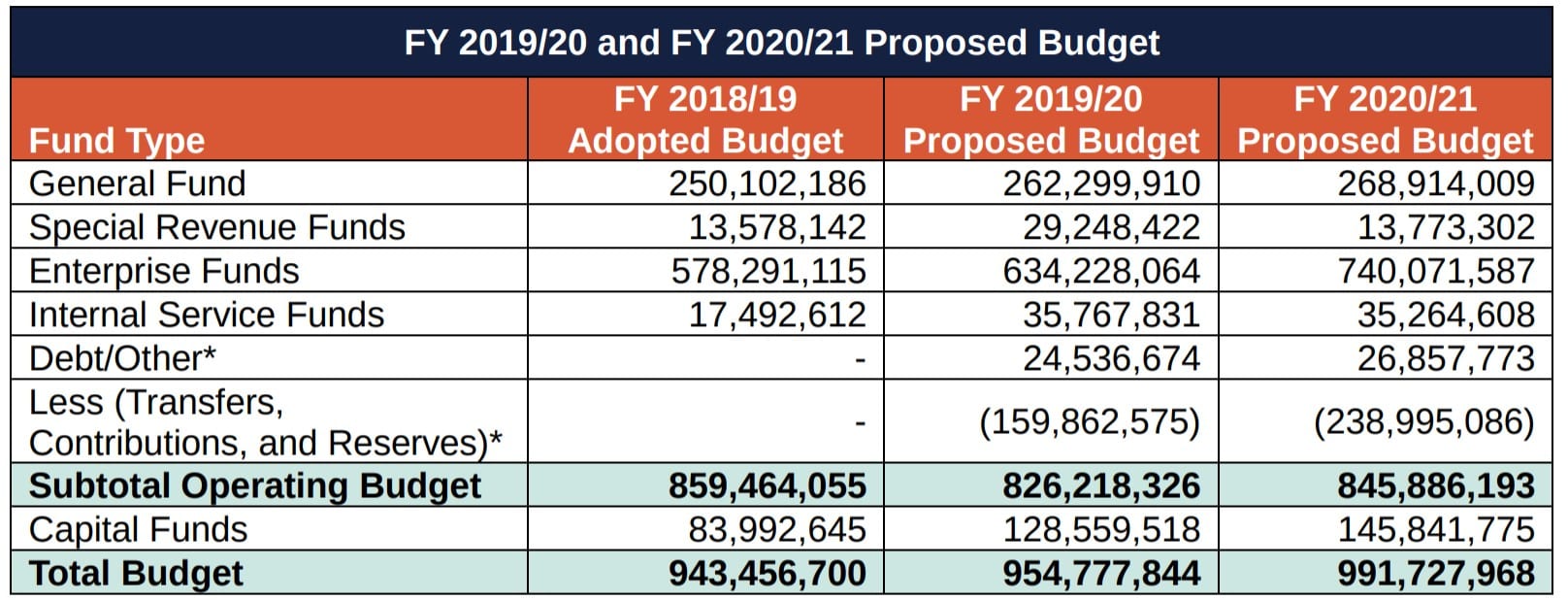Santa Clara city officials say they’ve balanced the city’s $954.8 million budget ahead of the City Council’s expected vote on the financial forecast on Tuesday.
City officials have tried over the past 18 months to find their way out of what was projected to be a $46.4 million deficit over the next two years as of June 2017. A year later, city leaders had revised that to a $10.2 million deficit projected between now and 2021. But on Thursday, City Manager Deanna Santana said Santa Clara was “in the black” for the coming years.
“Over the last months, we were able to continue this due diligence; in a $1 billion, multiple line-item budget, you need that time,” Santana said during a State of the City address Thursday. “Now, over 10 years, we’re in the black.”
For comparison, last year’s approved budget came to $943.46 million, or about $11 million less than the proposed 2019-2020 fiscal budget that starts July 1. Looking ahead, the 2020-2021 budget is set to ring in at $991.7 million, a nearly $37 million jump from year to year due to “rising salaries and benefits costs and the timing of capital projects,” according to the city.


Notably, Santa Clara’s 10-year forecast still shows a more than $2 million deficit projected between 2021 and 2023. Santana said she’ll continue to work on balancing that part of the budget while city staff members study ways to increase the city’s revenue via a new utility user tax, business taxes, real estate development or potentially raising the tax on hotel and lodging rentals, known as the transient occupancy tax.
Mayor Lisa Gillmor said in an interview Thursday the city still needs to consider those options despite closing its financial gap for the coming years.
“We still have to make sure that we’re protected and we don’t feel that way right now,” she said. “I’ll give you an example: the cannabis tax that our city passed … the revenue projections we had for what we were going to generate were really high when we were talking about it, and now they’ve come down dramatically.”
To date, the city has stored nearly $300 million in its reserve fund, the largest amount since the Great Recession hit, Gillmor said. Even so, city leaders say the current budget “remains on edge,” and could be significantly changed by an economic slowdown.
“Our largest revenues are property tax, sales tax, hotel tax, so those are very economically sensitive,” Kenn Lee, assistant finance director for the city, explained in an interview this week. “Any potential slowdown of the economy would impact sales tax tremendously and property and hotel tax.”
A two-year look ahead
Santa Clara is now working off a biennial budget, meaning it’s adopting a spending plan for two years at a time, alternating between focusing on the city’s operating needs and its capital needs.
The coming fiscal year budget focuses on operations, guided by seven “strategic pillars” adopted by the City Council. Those pillars include a new sustainability effort, housing and economic development, infrastructure, community engagement, ensuring no city public funds go toward Levi’s Stadium — because of Measure J — and staffing.
Santa Clara’s biennial budget calls for adding 15.5 net new positions in the coming years, including an analyst, aide and attorney focused on real estate and housing-related tasks. The city will also hire a sustainability officer and add to the finance and HR departments. Several existing roles at the city are changing or expanding to take on new responsibilities. Overall, the budget calls for a 5.4 percent increase in salary and benefits spending in the coming year, and another 5.1 percent jump the following fiscal year.
One-time costs also play a big role in this year’s forecast.
The one-time funding is “intended to guide managers through specific operational issues faced from processes that are overdue for update, reevaluation and/or revision,” according to a letter Santana wrote prefacing the proposed budget.
Among those costs: organizing the city’s accessory dwelling unit program, hiring a consultant to implement software that tracks affordable housing assets, updating the city’s records management systems and bringing on a consultant to assess Santa Clara’s fleet and look for ways to reduce ongoing costs.
One major initiative in those one-off costs, Santana said, is a $100,000 push for a robust Census 2020 process, which will determine how many federal dollars flow to Santa Clara in the coming decade. “Dollars that we invest now pay off over the next 10 years,” Santana said.
But the effort the city is touting perhaps even more than the number-crunching is the new redesign of the document itself, aimed at making the complex accounting of a city’s finances a little easier to parse.
“This budget is very transparent, whereas before it may not have been, and that to me is probably the biggest accomplishment,” Santa Clara spokeswoman Lenka Wright said in an interview this week. “If you compare it to last year’s [budget], you’ll see how much more information we’re providing… and people can actually follow the numbers a lot easier than before.”
Contact Janice Bitters at [email protected] or follow @JaniceBitters on Twitter.



Leave a Reply
You must be logged in to post a comment.